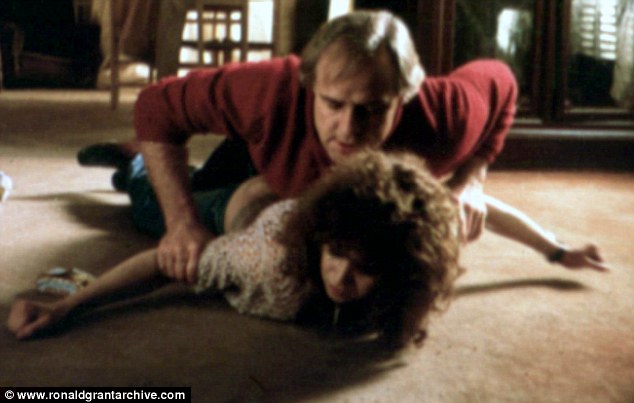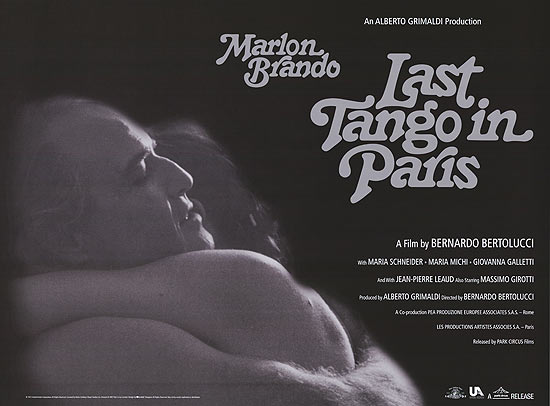There’s quite the media foxhunt in pursuit of Last Tango in Paris, Bernardo Bertolucci’s pants-down masterpiece from nearly half a century ago.
A film short on dialogue and long on intercourse, Last Tango caused quite the rumpus when first released in 1972, with people walking out, throwing up, picketing theatres and generally getting themselves nice and randy. It wasn’t just that Marlon Brando was 48 and Maria Schneider was only 19, or that the film featured more sex than your average 70s porn film, or even that some of the sex appeared to border on rape. What seemed to trouble everyone at the time was the heretical use of a dairy product.
In what is unarguably the film’s most ribald scene, Brando, attempting one of the bedroom’s more maligned manoeuvres, uses a cube of butter to get the ball rolling, to the evident vexation of his female guest. Though the entire film throws a swarm of question marks over the issue of consent (Brando’s character forces himself upon the young girl within minutes of meeting her), it was this particular scene that had everyone hot with fleas, and so it is again today.
During a 2013 interview that, for some reason, has only become news in the last few days, director Bernardo Bertolucci revealed that the butter scene came as something of a surprise to his young female star:
“The sequence of the butter is an idea that I had with Marlon in the morning before shooting it, because in the script he had to rape her, and we were having breakfast on the floor of the flat, and there was a baguette and there was butter, and we looked at each other, and without saying anything we knew what we wanted. But I’d been — in a way — horrible to Maria because I didn’t tell her what was going on. Because I wanted her reaction as a girl, not as an actress. I wanted her to react as if she felt humiliated … I think she hated me and also Marlon because we didn’t tell her that there was this detail of the butter used as a lubricant.”
Bertolucci’s memory appears to match, somewhat, with Schneider’s recollections as voiced during an interview with the UK’s Daily Mail in 2007:
“That scene wasn’t in the original script. The truth is it was Marlon who came up with the idea. They only told me about it before we had to film the scene and I was so angry. I should have called my agent or had my lawyer come to the set because you can’t force someone to do something that isn’t in the script, but at the time, I didn’t know that. Marlon said to me: ‘Maria, don’t worry, it’s just a movie,’ but during the scene, even though what Marlon was doing wasn’t real, I was crying real tears. I felt humiliated and to be honest, I felt a little raped, both by Marlon and by Bertolucci. After the scene, Marlon didn’t console me or apologise. Thankfully, there was just one take.”
One doesn’t have to be particularly intelligent to spot the glaring anomalies in this shared reminiscence; Bertolucci is explicit that a rape scene was in the script, that the butter was the only detail sprung at the last moment, while Schneider recalls the whole scene was unscripted. What both are in agreement about, however, is that everyone knew that a rape scene was about to be shot, Schneider herself making it clear that Bertolucci and Brando “told me about it before we had to film the scene”.
But opinions and journalism are fast and lazy in the Year of Our Lord, 2016, an era in which truths are certainly looser than morals, clicks more valued than facts, and the “engagement” of readers, as opposed to their enlightenment, appears to be the name of the game. So away the headlines went:

“That Famous Rape Scene In Last Tango In Paris Was In Fact Not Consensual” (The Huffington Post); “Last Tango in Paris Director Admits to Conspiring to Film Actual Rape” (The Hollywood Gossip); “Last Tango in Paris director admitted Marlon Brando committed rape on camera” (The Mercury News); “Last Tango in Paris Rape Was Real” (Gossip Cop). These, along with hundreds of similar stories echoing sentiments that Brando and Bertolucci “should be in jail”, or that all copies of the film “should be destroyed”, are not playing fair.
To say that the scene was “actual rape” is plainly false — there has never been a suggestion, by either Bertolucci or Schneider, that “rape” in fact occurred. (In the same Daily Mail article that forms the basis for such claims, Schneider is explicit when asked if the sex in the movie was actual: “Not at all.”) And those charges of non-consent are journalistic weasel words of convenience — while it’s clear Schneider was reluctant, and quite clearly coerced, the claim it was “not consensual” implies what we see on the screen is real, that at no point did Schneider agree to do the scene, when in fact her own testimony betrays this as nonsense: the scene was discussed, Brando assured her it wasn’t real, that it was “only a movie”, and then the scene was filmed.
This is not to say these revelations shouldn’t be of concern, particularly in an era when the quest for fame doesn’t seem to be dwindling in the young (there are, one would suspect, millions of teenagers today who would sign the same contract Schneider later regretted). But there is enough doubt embedded in this story — the mismatched recollections, the long-dead protagonists, the inherent untrustworthiness of an old wanker from Europe, who just might have been feathering his own mythology with a tale of the ‘genius’ who’ll stoop to any depth for his art — to warn any decent journalist to be careful, and it seems not a single one in the world felt compelled to take that opportunity.
The worst case of all can be found in Australia, in the pages of one of the nation’s most respected broadsheets, the Sydney Morning Herald. In an outraged opinion piece, a columnist claims Bertolucci “admits actress Maria Schneider never gave her consent … because the scene wasn’t in the script, so she had no idea it was going to happen until it did.”
That’s not true — Bertolucci was explicit that the scene was in the script. The piece continues:
“During that day’s sex scene, Brando would dip his fingers into the butter and use it to lubricate her anus, without any warning.”
Not true — all participants in the scene, including Schneider, deny that any penetration happened “at all”, a fact which the author concedes later in the piece:
“Now, you might think rape is too strong a word for it. After all, Schneider and Brando both went on the record to state that no actual intercourse ever took place. But assuming Schneider was digitally penetrated, as seems almost certainly to be the case, such an act would legally be considered rape or sexual assault, both in France and Australia.”
What? On what evidence does the author justify this assumption, bolstered by use of the words “almost certainly”? A feeling? Common sense?
There is, in fact, more evidence to suggest that Schneider made the whole story up — an eagle-eyed reader might have noticed that the interview for the Daily Mail in 2007 was conducted to coincide with the re-release of Last Tango in Paris “to mark the 35th anniversary of Bernardo Bertolucci’s iconic movie” (it’s there in the third paragraph). Movie folklore tells us that Schneider barely made a dollar out of the original release, and, considering the enduring acrimony between herself and Bertolucci, it’s unlikely she would have bothered doing media interviews for his re-release unless she had something to gain. It’s just possible that Schneider, having renegotiated a deal on Last Tango, might have seen some benefit in kicking up a bit of controversy (she admits, in the same interview, she “would make up stories for the press” in the past).
That’s not an entirely credible scenario either, but there’s as much evidence for it as there is for the ‘certainties’ expressed in the Sydney Morning Herald.
It’s entirely expected that bozos on Twitter would throw their knee-jerk responses into a groupthink, but exactly how journalists have come to be so careless and incurious is a bit of a mystery. An answer may be found, however, in a piece published overnight, once again in Australia, the authors two lecturers from Swinburne University of Technology, which prides itself on its journalism course:
“In the interview, Bertolucci reveals that a key scene in which Brando uses butter as a lubricant for sex was shot without Schneider’s consent … We now know that it was Maria the woman and not Jeanne the character who was fighting to get Brando’s imposing figure off her back. What we see onscreen is not a simulated rape but an actual instance of sexual abuse.”
Once again, this is not fair play, the strong inference being that Maria Schneider was raped, which even Schneider herself denied. The piece goes on:
“According to numerous acquaintances, the experience of shooting Last Tango in Paris haunted her for life. While it advanced both Brando and Bertolucci’s careers, earning them Oscar nominations, it left Schneider’s in shambles.”
Had the lecturers done a modicum of research, they would have found an interview conducted by Roger Ebert in 1975, three years after Last Tango in Paris, in which Schneider has “moved to America; signed with Paul Kohner (the legendary agent who represents Ingmar Bergman, Liv Ullmann and many other Europeans), turned down several big film offers, and moved into a house in the Hollywood hills” — not what any decent journalist would call a “shambles”. The piece continues:
“It is also worth remembering that Schneider, Brando and Bertolucci were not the only people present on the set for this scene. How many camera, sound and production crew have stayed silent for decades and remain complicit?”
Did it not occur to these lecturers to consider, for even a moment, that staying silent might be an entirely expected response to an incident that was of no special significance, or didn’t happen at all?
Those who lament that journalism has sunk so low as to consider tweets trustworthy material in lieu of eyewitnesses or facts, behold:
“Rightfully, a handful of Hollywood personalities have expressed their disgust through social media. Actors Jessica Chastain, Evan Rachel Wood and Anna Kendrick have denounced Bertolucci through Twitter, inviting us to re-evaluate both his and Brando’s body of work.” (In fact, Chastain tweeted not “rightfully”, but falsely: “To all the people that love this film — you’re watching a 19yr old get raped by a 48yr old man.”)
This is serious.
Last year, on White Ribbon Day — an annual date of awareness regarding the issue of violence against women — journalists in Australia dutifully reported the contents of a Government-sponsored press release telling of “damning new research” that revealed “while 96% of Australians condemn domestic violence, underlying attitudes entrench the problem”. The trouble having thus been identified as originating in Australian homes, the Government seemed justified in announcing a spend of a mere $30 million on an “awareness campaign”, letting them off the hook for the hundreds of millions for counsellors, shelters, lawyers and front-line workers so desperately needed in the fight against domestic violence. Not a single journalist in the country was curious enough to look into the source of the study, which was not a university or academic institution, but a market research company which, when not consigned by the Government to deliver the message it needs on time, is employed by brands that need to know how to sell their stuff.
By running with the herd — by refusing to be cautious and inquisitive, choosing instead to allow what’s “trending” to boss it around — journalism is failing the very people to whom it is masquerading as a watchdog and saviour.
“The fact that both Schneider and Brando are dead is irrelevant,” wrote the journalism lecturers from Swinburne.
No it isn’t. The fact that both Schneider and Brando are dead is the very reason for this craven nonsense, which required no phone calls or examination, but simply the modern journalist daily chore of checking to see which way the wind’s blowing.
Had Schneider been here, she would undoubtedly have told reporters what she’d already said about the man now being vilified as her “rapist”:
“I watched it again three years ago after Marlon died and it seems kitsch … Now, though, I can look at the film and like my work in it.
“So much of that was because of Brando. He was wonderful to work with, for an actor like myself who was still beginning. He had just finished The Godfather, and now this was also part of his comeback, and you’d think he’d want the advantage in all of the scenes. Actors always try to look their best. But he gave me the advantage, the material to work with. And he was brilliant when we improvised …”






You said: “One doesn’t have to be particularly intelligent to spot the glaring anomalies in this shared reminiscence; Bertolucci is explicit that a rape scene was in the script, that the butter was the only detail sprung at the last moment, while Schneider recalls the whole scene was unscripted. What both are in agreement about, however, is that everyone knew that a rape scene was about to be shot, Schneider herself making it clear that Bertolucci and Brando “told me about it before we had to film the scene”.
From her words “told me about it before we had to firm the scene” doesn’t derive the knowledge that the scene was scripted. She said she only was informed right before the moment they had to shoot that scene.
Another point: don’t you think that not having in the script the “detail” of the butter is unprofessional? The scene should be portrayed exactly as it will happen in the script.
I agree with your many points, but also I think they took advantage of the fact she was so young and unexperienced. Had she been a mature woman, they wouldn’t have dared to add extra sexual element into the scene without a more proper consent approach.
Some very good points, but unfortunately also some of the journalistic sluggishness criticized in other writers. For instance, it says here
“It’s just possible that Schneider, having renegotiated a deal on Last Tango, might have seen some benefit in kicking up a bit of controversy (she admits, in the same interview, she “would make up stories for the press” in the past).”
when in fact in the original interview referred and linked to here, she says:
“People thought I was just like my character and I would make up stories for the press, but that wasn’t me.”
Hey, it’s Michael, not Mark! 🙂
So you are saying you think when she said “people thought I was just like my character and I would make up stories for the press, but that wasn’t me”, she didn’t mean “… people thought that I was like my character and that character would make up stories, but I didn’t because I wasn’t like that (making up stories)” but she meant “…that I was like my character and I made up stories to cater to that expectation, but the stories weren’t who I was”?